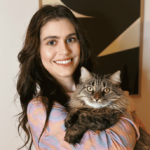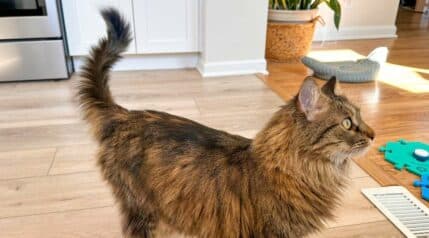When you purchase through links on our site, we may earn a commission. Here’s how it works.
While cats are known to be meticulous groomers, that cleanliness doesn’t extend to around the household. For those who dread finding clumps of hair here, there, and everywhere, you may be looking for a non-shedding cat.
Alternatively, maybe you’re desperate for a feline companion, but your allergies make it impossible to live around cats all day. A hypoallergenic cat would give you all the cuddles you crave without the itchy eyes and runny nose.
While there’s no such thing as a non-shedding or hypoallergenic cat, many breeds have minor to moderate shedding. Explore all the cat breeds that don’t shed much below and find the perfect option to suit your lifestyle and health needs.
Do All Cats Shed?
Yes, all cats shed to remove damaged hair and release oils onto their skin’s surface. Like humans, felines have a four-stage hair growth cycle:
- Anagen: During the anagen phase, new hair grows in quickly.
- Catagen: A transition phase for hair. During this transitional phase of the cycle, fur stops growing because it has reached full length.
- Telogen: During the telogen phase, hair neither grows nor falls out. It is considered the resting period.
- Ecogen: Shedding occurs during this stage. Existing hair falls out (sheds), allowing new hair growth.
According to Healthline, you (and your pet) can maintain hair health throughout all stages by practicing good nutrition.
How To Control Shedding
According to VCA Animal Hospitals, 25 percent of all cat visits to the veterinarian involve problems with the skin and coat. This includes problems with excessive shedding. While you can’t stop shedding, there are ways to control the amount of fur tumbleweeds you find around your home.
5 Ways To Control Shedding
- Brush your cat regularly. Brushing will pick up loose hair before it falls out and makes its way onto the surfaces in your home.
- Maintain a moderate temperature in your home. Cats tend to shed more when it’s warm, so a cooler home will reduce shedding. Keep your kitty inside when the heat spikes outside to prevent overheating and control shedding.
- Give your cat a once-a-month bath using feline-safe shampoo. While baths aren’t necessary for cats, they help remove loose hair and saliva, which contribute to cat allergies.
- Keep your furry friend hydrated. Adequate hydration is essential for a healthy coat and reduced shedding. Regularly wash your cat’s water bowl to prevent bacteria and debris buildup. Consider a cat water fountain to encourage more drinking.
- Use air purifiers and a quality vacuum to reduce hair and allergens throughout the home. Cat grooming vacuums are available that function as three-in-one deshedder, brush, and vacuum, making brushing and cleanup quick and easy.
Cats That Don’t Shed A Lot
Even hairless cats shed occasionally, but some breeds shed significantly less than their feline companions. Keep in mind that for those with cat allergies, you’re likely allergic to the proteins in a cat’s cat’s saliva, urine, and dander. So, even if your cat doesn’t have a lot of hair, you still may react when around them. Interestingly, some breeds (like the Siberian and Balinese) produce less of the Fel-d1 allergen—one of the proteins responsible for cat allergies—so these breeds may be a good fit for allergy sufferers.
The following are low-shedding cats, listed from bald to moderate-shedding.
Sphynx

The Sphynx is a small to medium-sized bald cat, though they can also have fine hair. Thanks to their wrinkled skin, lemon-shaped eyes, large ears, and finger-like toes, you’ll recognize a Sphynx. This breed will have different degrees of hairlessness. The hairless gene is recessive, so a Sphynx bred with a furry feline may not produce hairless kittens. People consider the Sphynx to be hypoallergenic.
Donskoy

Donskoys are naked cats with a few different coat types: rubber bald, flocked, velour, and brush. They can be born hairless (rubber bald) or with a thin peach fuzz that disappears over time. Flocked cats appear hairless when born but have a thin coat, the texture of soft chamois. Eventually, they will lose their fur and become completely bald. Velour felines are born with a wavy coat and bald spot on the top of their head; their coat will gradually disappear within the first year. Brushed cats are born with soft, wavy, bristly, or wiry fur, and only a portion of the coat disappears.
Unlike Sphynx cats, whose hairlessness is caused by a recessive mutation, Donskoy’s baldness is a dominant mutation. Donskoy cats require additional maintenance like all naked breeds because they’re prone to dry skin and skin irritations/infections.
Peterbald

Another naked cat breed, the Peterbald will be totally hairless or have light fur. Like the Donskoy, Peterbald’s hairlessness is caused by a dominant gene; however, this gene is not very predictable. Kittens from the same litter can be completely bald or have wiry hair. The breed has three basic coat types: bald, velour, and brush. Velour cats have a peach-fuzz coat that feels velvety soft. The brush coat is composed of wiry, curly hair. The coat is very sparse; you can typically see through to the skin.
All Peterbalds are low-shedding and are considered low-maintenance. Remember that hairless varieties benefit from an occasional bath or wipe-down to remove excess skin oils.
Lykoi

Fondly nicknamed the “werewolf cat,” the Lykoi is unique in that it won’t continuously shed; instead, it molts a few times a year. This breed is derived from a natural mutation that causes hypotrichosis, presenting as a reduced number of follicles able to produce hair so that the feline has less hair than usual. Lykoi have no undercoat and think top hairs. They vary from being covered in sparse hair to completely hairless.
Lykoi are born with black hair, but the hair falls out within two to three weeks. At five weeks, black and white hairs will grow back (to varying degrees). Lykoi do molt and shed their entire coat a few times a year. While they shed bunches of hair at a time, they have less fur than other breeds, and you only have to deal with molting a few times a year.
Cornish Rex

The Cornish Rex is a curly-haired cat with a thin frame covered in tight, short curls. This feline has a narrow head, oversized ears, curly whiskers, and long legs and tail. The breed is known for being high energy and affectionate, so they need a home with lots of activity. While the Cornish Rex isn’t a naked breed, their velvety-soft coat is short, lies close to their body, and sheds less than other cats.
Devon Rex

The Devon Rex is similar to the Cornish Rex but tends to have a more petite frame. This breed is also more independent, making it an ideal option for those who aren’t home as often. The Devon Rex is known for their pixie-like appearance and mischievous ways. This breed has curly, short hair and sheds very little.
Siamese

The Siamese breed has the most low-maintenance coats of all breeds on this list. They shed minimally and don’t require regular baths or extra grooming. Siamese are known for their chatty nature, beautiful colorpoint coats, and striking blue eyes.
Colorpoint Shorthair

The Colorpoint Shorthair is a cross between the Siamese breed and the American Shorthair cat. They are nearly identical to Siamese cats, apart from their colors. Colorpoint shorthairs are highly intelligent, people-friendly, and playful.
Burmese

Burmese cats are known as small felines with fine coats. Because they have less hair than the average cat, they also shed less. These kitties are super loving and affectionate, so expect a constant companion if you bring a Burmese into your home.
Burmese are excellent for owners who enjoy interacting with their cats throughout the day. Burmese cats also have a long life expectancy, typically 20 to 25 years.
Bengal

The Bengal breed derives its name from the Latin name of its wild ancestor, Felis Bengalensis, commonly known as the Asian leopard. Bengals are known for their beautiful, exotic-looking coats that are low-shedding. The Bengal breed is considered hypoallergenic. Bengals are considered energetic, playful, and highly active. They require a home that can match their over-the-top energy.
Bombay

Known for their panther-like appearance, Bombays are entirely black cats with short, tight coats that shed minimally compared to other cat breeds. Occasional brushing will keep their coats extra glossy. Bombay felines are active and curious. They are very affectionate and are friendly with children and other pets.
Russian Blue

The Russian Blue breed is known for its dense, bluish-gray double coat that feels plush. Their fur is short and velvety soft. Despite their thick coat, Russian Blues do not shed very much. You’ll only have to worry about shedding twice a year. You may want to increase brushing during the spring shedding season. Brushing will also ensure your cat maintains a shiny coat.
Because Russian Blues produce less Fel d 1 protein, they are considered more hypoallergenic than your average cat. Personality-wise, Russian Blue cats are affectionate, shy around newcomers, and independent.
Singapura

The Singapura is a rare cat breed known for being one of the smallest cat breeds in the world. While tiny in stature (no more than five pounds), these felines have big personalities. They are incredibly sprightly and agile. Singapuras have a short coat that is low-shedding and requires little grooming.
Birman

On first look, the Birman’s long, fluffy coat may make you believe that they’ll shed all over the place; however, despite their fluffiness, they are low shedders. Birman cats have relatively low shedding because they have a single coat that doesn’t get easily matted. This breed is a good option if you love long-haired cats but can’t dedicate much time to grooming.
Birman are considered more hypoallergenic than other breeds. They require minimal brushing, and their coats are easy to care for and maintain. Overall, the breed is known to be affectionate, intelligent, and family-friendly.
Exotic Shorthair

For those obsessed with the Persian breed but can’t stand the shedding, consider the Exotic Shorthair. This breed was developed as a short-haired version of the beloved Persian. Despite their extremely thick coats, Exotic Shorthairs are relatively low shedders.
Final Thoughts
Unfortunately, there aren’t any cats that don’t shed, but there are low-shedding options. Looking for more ways to keep your home fur-free? We share our top picks for cat brushes and air purifiers. Wondering why your cat is shedding so much? Review the causes of excessive shedding in cats.




